It would take 810,000 people riding bikes to do as much cumulative damage to the road as one person driving an SUV.
By Ryan McGreal
Published December 02, 2016
Bad civic policy ideas never seem to go away; like bad pennies, they keep turning up at the worst times. One such coin that predictably turns up is the knee-jerk proposal to start licencing bicycles, which inevitably manifests during any debate over cycling infrastructure.
Most recently, it reared its ugly head during last week's Council debate over the protected cycle track planned for the Claremont Access.
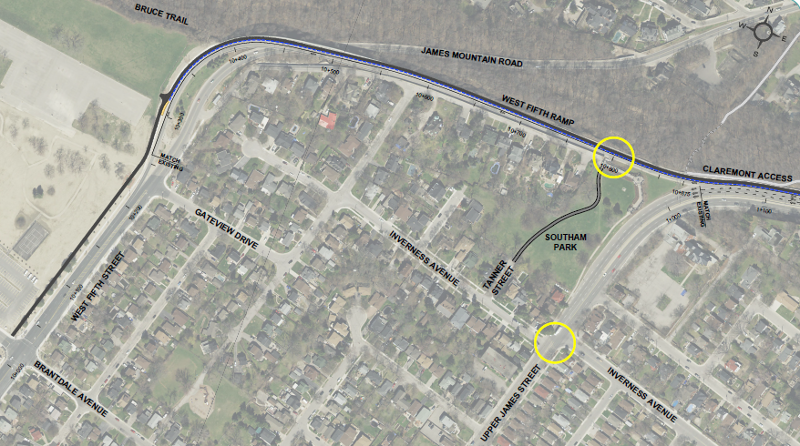
Claremont Cycle Track upper portion rendering (Image Credit: City of Hamilton)
This dumb idea should be easy to put to bed. After all, it's based on the premise that licencing bicycles will somehow make them "pay their share" for cycling infrastructure.
This premise is fundamentally wrong-headed and needs to depart from the policy debate once and for all.
The City's official, council-approved strategic goal for cycling is to increase the number of bike trips in Hamilton, but a bike licencing system would achieve the opposite goal and reduce the number of bike trips.
The very concept of licencing bikes is a basic misapplication of the municipal policy tool of licencing. The main reason to licence an activity is to restrict and regulate it so the City can exercise oversight, usually for public health and safety reasons.
Consider the list of businesses that must apply for a business licence (pp. 33-4) in Hamilton. These are all categories of business with significant public health and safety implications: food services, accommodations, personal services, tobacco retailers, taxis, construction trades, and so on.
The purpose of the business licence system is not to generate funds but rather to ensure that the public is protected from reckless or unscrupulous owners and operators.
This is also why the City requires dog owners to obtain a dog licence: an unregulated dog with an irresponsible owner is a significant danger to public health and safety.
(Sidenote: to be productive, a Council discussion about a proposed cat licence should be framed in the same way: does a cat licence help the City reduce a significant danger to public health and safety?)
The reason why the Province requires people to obtain a driver's licence to drive and a vehicle permit to operate a vehicle (with mandatory insurance coverage) is that driving is extremely dangerous.
Motor vehicle collisions kill 3,000 people a year in Canada and injure many tens of thousands more.
Bicycles, not so much.
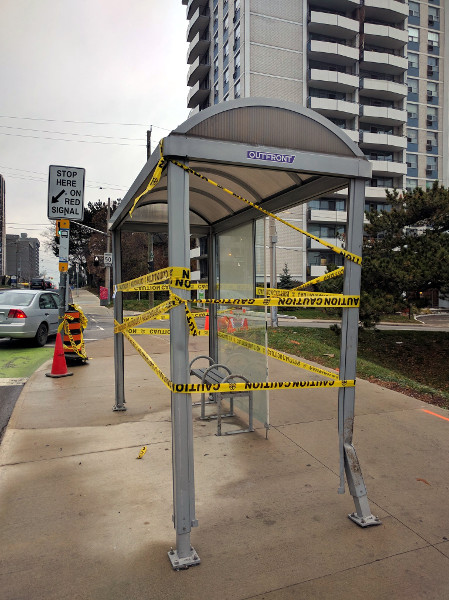
This bus shelter at Hunter and Bay was struck by a person driving a car, not a person riding a bike
In areas where the city licences an activity, most or all of the money collected under the licence application goes to pay for the administration of the licencing system and regulation of the licenced activity, not to collect revenue for general program spending.
Under any licencing system for cyclists, the administration of the system - including enforcement - would consume whatever money was collected in licence fees. The result would be a pointless new government bureaucracy and a net reduction in the number of bike trips.
Yet this basic fact doesn't stop the usual posturing councillors and culture war provocateurs to insist that cyclists should be made to "pay their share" for street infrastructure.
I can't believe this even needs to be pointed out, but Hamilton's municipal streets are funded mainly through property tax revenue, not driver fees. Since everyone pays property tax, people riding bikes are already "paying their share".
In fact, a very strong argument can be made that when someone chooses to ride a bicycle instead of driving for a trip, that person is actually paying far more than their fair share.
A big part of the overall lifecycle cost of a road is the maintenance and resurfacing cost due to wear-and-tear. It's vitally important to understand that the engineering rule of thumb for roadway wear-and-tear is that it's a fourth-power exponential function of the vehicle's axle weight.
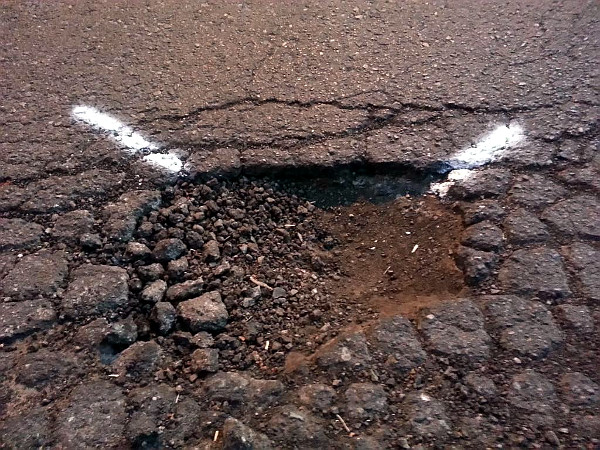
Pothole marked for filling (RTH file photo)
A linear function would mean that a vehicle twice the weight did twice the damage, and a geometric function would mean that a vehicle twice the weight did four times the damage. (For example, it's a geometric function to calculate the kinetic energy of a moving vehicle.)
What a fourth-power exponential function means is that a vehicle twice the weight does sixteen times the damage.
Let's compare the relative damage of a bicycle's axle weight to some other vehicles that use public roads.
| Bicycle | Small Car | Big Car | SUV | Semitrailer | |
|---|---|---|---|---|---|
| The weight and damage multiple for each vehicle is in comparison to a person on a bicycle. | |||||
| Axle Weight (kg) | 45 | 600 | 900 | 1,350 | 9,000 |
| Weight Multiple | 1 | 13 | 20 | 30 | 200 |
| Damage Multiple | 1 | 31,605 | 160,000 | 810,000 | 1,600,000,000 |
A person driving a small car does more than 31,000 times as much damage to the road as a person riding a bike. That means it would take more than 31,000 people riding bikes on the street to do as much cumulative damage as a single person driving one small car.
If the person is driving a sedan rather than a small car, it would take 160,000 people riding bikes to do as much cumulative damage as that one car driver.
If the person is driving an SUV, it would take a whopping 810,000 people riding bikes to do as much cumulative damage as that one car driver.
And if we compare a bike to a semitrailer transport truck, it would take a mind-boggling one billion, six hundred million people riding bikes to do as much damage to the road as that single truck.
A vehicle licence plate sticker costs $120 for a year. That works for any size car, light truck or SUV, but let's be conservative and calculate a comparable bike permit cost given the wear-and-tear differential between a bike and a small car.
We would have to charge $0.0004, or four-hundredths of a penny.
Can anyone learn this and still claim with a straight face that peop are somehow not "paying their way" for using the road when they choose to ride a bike?
While Council agonizes over whether to spend the money to install jersey barriers on an upbound lane of the Claremont Access to safely accommodate cyclists, the City went ahead and installed jersey barriers on a downbound lane of the Claremont Access to safely accommodate drivers without any grandstanding whatsoever.
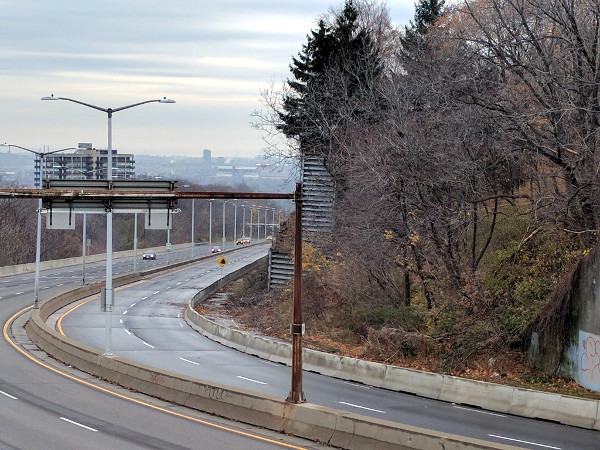
Council didn't have to debate whether to protect drivers on the Claremont Access
The total annual cycling budget is less than one percent of the total roadway budget, but bike infrastructure projects consume a vastly disproportionate amount of Council's time and energy.
Enough with the double standard. Council approves hugely expensive roadway projects without so much as a peep while every cycling project turns into a huge pitched battle with self-styled champions of the status quo framing it as some kind of culture war provocation instead of just responsible policy.
It's the same old divisive, us-vs-them wedge politics that continues to pit this city against itself, stoke Trumpian anger and resentment, and waste huge amounts of energy that we could otherwise direct into building a stronger, more inclusive city for everyone - including the majority of people who consistently say they want to bike more but are afraid to ride unprotected in mixed traffic.
After all, what prompted Council to look at expediting the Claremont Cycle Track in the first place was the death, one year ago, of a west Mountain resident who was struck and killed by a motorist while riding his bike home from his job as a school teacher.
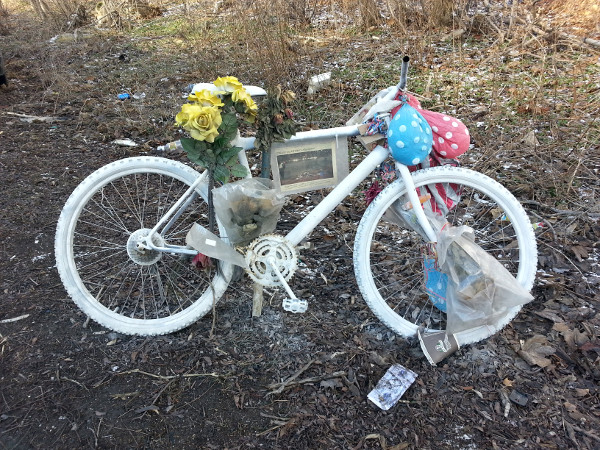
'Ghost bike' memorial for Jay Keddy (RTH file photo)
By KevinLove (registered) | Posted December 02, 2016 at 10:02:08
The City of Toronto, in response to irresponsible city councillors created a web page after studying this issue to death. Needless to say, they concluded that it was A Very Bad Idea.
Perhaps the City of Hamilton should create a similar page on their web site.
Comment edited by KevinLove on 2016-12-02 10:02:42
By Tybalt (registered) | Posted December 02, 2016 at 10:37:21
Is it churlish of me to point out that the City also receives ZERO PER CENT of the licensing fees paid by drivers?
By kevlahan (registered) | Posted December 02, 2016 at 10:46:00
The worst part of all this is the myth that cyclists don't pay their share of the cost of building and maintaining roads, even though municipal roads are paid for primarily out of property taxes that every cyclists pays!
Provincial and federal road infrastructure is partially funded by special motorist-associated taxes, but they don't cover the full cost (and cyclists can't even use the freeways that are a major part of provincial and federal spending on roads).
And, of course, the road space and wear and tear cyclists impose on roads is a tiny fraction of what a motorist uses. So, as Ryan says, someone who mostly cycles is vastly over-paying, not underpaying (and they pay the road costs for trucking the goods they consume since the cost of taxes and fees is passed on to the end consumer).
Even more blatant, the City of Hamilton does not even receive any of the license fee money to spend on its roads (it is spent on Provincial roads)! Why did Terry Whitehead even bring up licensing when the City doesn't receive any license fee money from the Province?
What would a bicycle license cost?
In Ontario a motor vehicle costs $120 to license, while a moped costs $12 (one tenth). Based on this, it would be extremely unfair to charge more than about $6 or so for a bicycle, even if you thought licensing bikes was a good idea. Clearly this would generate essentially no useful amount of revenue after the costs of administration and enforcement were included!
There is no example of a jurisdiction using bike licensing as a way to generate significant amounts of revenue to spend on cycling infrastructure. The few places that do have bike licensing use it as a way to discourage theft and recover lost or stolen bikes.
Comment edited by kevlahan on 2016-12-02 10:54:04
By Tybalt (registered) | Posted December 02, 2016 at 10:56:26
I don't want to derail the conversation but you asked: "to be productive, a Council discussion about a proposed cat licence should be framed in the same way: does a cat licence help the City reduce a significant danger to public health and safety?"
The answer is yes, if the system is properly implemented: cat licensing to be effective is part of a wider cat control strategy aimed (properly) at eliminating a highly dangerous exotic and invasive species. Aside from the disease vector they present (which is really not that large) feral cats are massively destructive of our natural wildlife and a serious danger to a healthy ecosystem. If we take our natural environment and biodiversity seriously at all, cat control is critical because they are an existential danger to many local species.
Of course, it looks like the aim is to adopt an ineffective trap/neuter/release strategy married to the licensing, which won't have enough of the desired effect. But married to a strategy to actually reduce (rather than control) invasive feral populations, it has a significant impact on public health and safety.
By KevinLove (registered) | Posted December 02, 2016 at 19:35:12 in reply to Comment 120501
Ryan, you need to acquire a set of prejudices. The great advantage of a properly functioning set of prejudices is that they enable one to reach an opinion on any issue without having to take the time and trouble to research such annoying things as facts.
Advanced practitioners of the art of prejudice can even develop the ability to make up facts out of their own head.
By notlloyd (registered) - website | Posted December 02, 2016 at 20:50:04
One really has to ask what the point of a license is.
A license is a permission. In England in the middle ages you needed a license to travel between communities. We have come a long way. In free countries we don't need permission to travel and in fact our Charter protects mobility rights. I would argue we have a right to travel. So we have a right to walk. We have a right to bike. We have a right to boat. But for the danger of auto travel I would argue we have a right to drive.
We use licenses as government control when public interest demands it. So we license doctors and lawyers and welders because we don't want people to die when quacks misdiagnose, when people go to jail because they are defended by people who don't know what they are doing and to save us from nuclear catastrophe when welded pipes burst in nuclear reactors. What pray tell is the overarching public safety issue that requires bicycle licensing?
It's a red herring.
By JasonL (registered) | Posted December 03, 2016 at 09:02:08
Not sure if anyone saw this in the Spec, but one of the up-bound Claremont lanes will be converted to a down-bound lane within 2 weeks.
We've finally figured out how to get a lane on the Claremont for a cycle track: tell city hall it's for cars.
My schedule was a bit wonky the last 2 days and I ended up making 8 trips up and down the Mountain at times like 8:30am, 4pm, 5:30pm, 6:30pm etc..... I didn't see a single bit of 'congestion'. Reading the Spec story makes it sound like it's been NYC around here this week.
I can only assume that someone hit an extra red light on their commute, hence, "congestion".
By notlloyd (registered) - website | Posted December 03, 2016 at 12:34:28 in reply to Comment 120506
Some young mother friends of mine who live on the mountain and come down to work tell me their morning commute has increased on average by about 15-20 minutes since the road was closed.
Speaking of NYC have you read this http://nypost.com/2016/12/02/new-york-ci...
By AnonymousAdam (registered) | Posted December 03, 2016 at 12:47:30 in reply to Comment 120507
I agree with this. Claremont is my main access, besides when I need to go North or West I use James Hill. (I live in Southam) and easily my commute to work within the city has doubled. Jolly is backed up to around the big bend near the top, James is backed up to Gateview. Adding to it is for some reason every bus leaves McNab at the same time and all of them go up the 2 lane accesses and none of them use Claremont (when its healthy) They need to stagger the buses. As for bike licensing. I only use my bike for trails, even if I commuted on it I would not agree with licensing. What I would like to see is mandatory insurance. Anything that uses the road with potential severe injury should be insured. The blame is not always with the driver.
By JasonL (registered) | Posted December 04, 2016 at 17:40:18 in reply to Comment 120507
this piece is fabulously hilarious. Someone should remind the author that human beings have been around since pre 2003. I remember in the 90's being in a legendary NYC traffic jam where we went 2 blocks in 2 hours. The population was 7.3 million then. It's 8.5 now. Anyone who thinks they should be encouraging auto traffic should be writing for the Onion.
By DowntownInHamilton (registered) | Posted December 06, 2016 at 22:33:09
If municipal bike licensing is a thing, I'd expect to see municipal car licensing next.
You must be logged in to comment.
There are no upcoming events right now.
Why not post one?